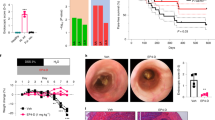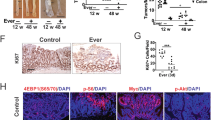Abstract
Arachidonic acid is metabolized to prostaglandin H2 (PGH2) by cyclooxygenase (COX). COX-2, the inducible COX isozyme, has a key role in intestinal polyposis1,2. Among the metabolites of PGH2, PGE2 is implicated in tumorigenesis because its level is markedly elevated in tissues of intestinal adenoma and colon cancer3. Here we show that homozygous deletion of the gene encoding a cell-surface receptor of PGE2, EP2, causes decreases in number and size of intestinal polyps in ApcΔ716 mice (a mouse model for human familial adenomatous polyposis). This effect is similar to that of COX-2 gene disruption. We also show that COX-2 expression is boosted by PGE2 through the EP2 receptor via a positive feedback loop. Homozygous gene knockout for other PGE2 receptors, EP1 or EP3, did not affect intestinal polyp formation in ApcΔ716 mice. We conclude that EP2 is the major receptor mediating the PGE2 signal generated by COX-2 upregulation in intestinal polyposis, and that increased cellular cAMP stimulates expression of more COX-2 and vascular endothelial growth factor in the polyp stroma.
This is a preview of subscription content, access via your institution
Access options
Subscribe to this journal
Receive 12 print issues and online access
$209.00 per year
only $17.42 per issue
Buy this article
- Purchase on Springer Link
- Instant access to full article PDF
Prices may be subject to local taxes which are calculated during checkout



Similar content being viewed by others
References
Taketo, M.M. Cyclooxygenase-2 inhibitors in tumorigenesis. Part I. J. Natl. Cancer Inst. 90, 1529–1536 (1998).
Taketo, M.M. Cyclooxygenase-2 inhibitors in tumorigenesis. Part II. J. Natl. Cancer Inst. 90, 1609–1620 (1998).
Yang, V.W. et al. Size-dependent increase in prostanoid levels in adenomas of patients with familial adenomatous polyposis. Cancer Res. 58, 1750–1753 (1998).
DeWitt, D.L. & Smith, W.L. Primary structure of prostaglandin G/H synthase from sheep vesicular gland determined from the complementary DNA sequence. Proc. Natl. Acad. Sci. USA 85, 1412–1416 (1988).
Xie, W.L., Chipman, J.G., Robertson, D.L., Erikson, R.L. & Simmons, D.L. Expression of a mitogen-responsive gene encoding prostaglandin synthase is regulated by mRNA splicing. Proc. Natl. Acad. Sci. USA 88, 2692–2696 (1991).
Kujubu, D.A., Fletcher, B.S., Varnum, B.C., Lim, R.W. & Herschman, H.R. TIS10, a phorbol ester tumor promoter-inducible mRNA from Swiss 3T3 cells, encodes a novel prostaglandin synthase/cyclooxygenase homologue. J. Biol. Chem. 266, 12866–12872 (1991).
Kargman, S.L. et al. Expression of prostaglandin G/H synthase-1 and -2 protein in human colon cancer. Cancer Res. 55, 2556–2559 (1995).
Oshima, M. et al. Suppression of intestinal polyposis in ApcΔ716 knockout mice by inhibition of cyclooxygenase 2 (COX-2). Cell 87, 803–809 (1996).
Oshima, M. et al. Loss of Apc heterozygosity and abnormal tissue building in nascent intestinal polyps in mice carrying a truncated Apc gene. Proc. Natl. Acad. Sci. USA 92, 4482–4486 (1995).
Gupta, R.A. & DuBois, R.N. Aspirin, NSAIDS, and colon cancer prevention: mechanisms? Gastroenterol. 114, 1095–1098 (1998).
Steinbach, G. et al. The effect of celecoxib, a cyclooxygenase-2 inhibitor, in familial adenomatous polyposis. N. Engl. J. Med. 342, 1946–1952 (2000).
Coleman, R.A., Smith, W.L. & Narumiya, S. International Union of Pharmacology classification of prostanoid receptors: properties, distribution, and structure of the receptors and their subtypes. Pharmacol. Rev. 46, 205–229 (1994).
Morimoto, K. et al. Cellular localization of mRNAs for prostaglandin E receptor subtypes in mouse gastrointestinal tract. Am. J. Physiol. 272, G681–G687 (1997).
Ushikubi, F. et al. Impaired febrile response in mice lacking the prostaglandin E receptor subtype EP3 . Nature 395, 281–284 (1998).
Segi, E. et al. Patent ductus arteriosus and neonatal death in prostaglandin receptor EP4-deficient mice. Biochem. Biophys. Res. Commun. 246, 7–12 (1998).
Tjandrawinata, R.R., Dahiya, R. & Hughes-Fulford, M. Induction of cyclo-oxygenase-2 mRNA by prostaglandin E2 in human prostatic carcinoma cells. Br. J. Cancer 75, 1111–1118 (1997).
Hinz, B., Brune, K. & Pahl, A. Cyclooxygenase-2 expression in lipopolysaccharide-stimulated human monocytes is modulated by cyclicAMP, prostaglandin E2, and nonsteroidal anti-inflammatory drugs. Biochem. Biophys. Res. Commun. 278, 790–796 (2000).
Williams, C.S., Tsujii, M., Reese, J., Dey, S.K. & DuBois, R.N. Host cyclooxygenase-2 modulates carcinoma growth. J. Clin. Invest. 105, 1589–1594 (2000).
Cheng, T., Cao, W., Wen, R., Steinberg, R.H. & LaVail, M.M. Prostaglandin E2 induces vascular endothelial growth factor and basic fibroblast growth factor mRNA expression in cultured rat Muller cells. Invest. Ophthalmol. Vis. Sci. 39, 581–591 (1998).
Holash, J., Wiegand, S.J. & Yancopoulos, G.D. New model of tumor angiogenesis: dynamic balance between vessel regression and growth mediated by angiopoietins and VEGF. Oncogene 18, 5356–5362 (1999).
Hewitt, R.E. et al. Laminin and collagen IV subunit distribution in normal and neoplastic tissues of colorectum and breast. Br. J. Cancer 75, 221–229 (1997).
Daniel, T.O., Liu, H., Morrow, J.D., Crews, B.C. & Marnett, L.J. Thromboxane A2 is a mediator of cyclooxygenase-2-dependent endothelial migration and angiogenesis. Cancer Res. 59, 4574–4577 (1999).
Prescott, S.M. & White, R.L. Self-promotion? Intimate connections between APC and prostaglandin H synthase-2. Cell 87, 783–786 (1996).
Watanabe, K. et al. Role of the prostaglandin E receptor subtype EP1 in colon carcinogenesis. Cancer Res. 59, 5093–5096 (1999).
Yamada, Y. et al. Frequent β-catenin gene mutations and accumulations of the protein in the putative preneoplastic lesions lacking macroscopic aberrant crypt foci appearance, in rat colon carcinogenesis. Cancer Res. 60, 3323–3327 (2000)
Takaku, K et al. Suppression of intestinal polyposis in ApcΔ716 knockout mice by an additional mutation in the cytosolic phospholipase A2 gene. J. Biol. Chem. 275, 34013–34016 (2000)
Acknowledgements
We thank K. Hioki and N. Shimozawa for breeding mice; and H. Seno, S. Iwasaki and S. Hagiwara for assistance. This study was supported in part by the Joint Research Fund between the University of Tokyo and Banyu Pharmaceutical, grants from the Ministry of Education, Science, Sports and Culture (MESSC; Cancer Research) and the Organization for Pharmaceutical Safety and Research (OPSR), Japan.
Author information
Authors and Affiliations
Corresponding author
Rights and permissions
About this article
Cite this article
Sonoshita, M., Takaku, K., Sasaki, N. et al. Acceleration of intestinal polyposis through prostaglandin receptor EP2 in ApcΔ716 knockout mice. Nat Med 7, 1048–1051 (2001). https://doi.org/10.1038/nm0901-1048
Received:
Accepted:
Issue Date:
DOI: https://doi.org/10.1038/nm0901-1048
This article is cited by
-
COX 2-inhibitors; a thorough and updated survey into combinational therapies in cancers
Medical Oncology (2024)
-
Role of microRNAs in regulation of doxorubicin and paclitaxel responses in lung tumor cells
Cell Division (2023)
-
Nanomolar EP4 receptor potency and expression of eicosanoid-related enzymes in normal appearing colonic mucosa from patients with colorectal neoplasia
BMC Gastroenterology (2022)
-
Metabolism pathways of arachidonic acids: mechanisms and potential therapeutic targets
Signal Transduction and Targeted Therapy (2021)
-
Acute changes in colonic PGE2 levels as a biomarker of efficacy after treatment of the Pirc (F344/NTac-Apc am1137) rat with celecoxib
Inflammation Research (2020)



